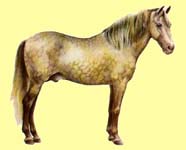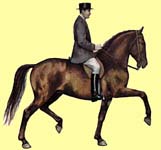|
|
Andalusian |
|
|
Andalusian |
| Group | Warmblood |
|---|---|
| Influences |
|
| Characteristics |
|
| Colors |
|
| Odd Facts |
|

 Originating in the hot temperate environment of Spain, the Andalusian is today geographically distributed throughout Europe and South America. It makes a good jumper and is an excellent riding horse with a balanced and energetic temperament. The Andalusian is a horse of the mesomorphic type with a
grey,
bay,
black,
chestnut or
roan coat, though typically found in bay and grey.
Originating in the hot temperate environment of Spain, the Andalusian is today geographically distributed throughout Europe and South America. It makes a good jumper and is an excellent riding horse with a balanced and energetic temperament. The Andalusian is a horse of the mesomorphic type with a
grey,
bay,
black,
chestnut or
roan coat, though typically found in bay and grey.
With pre-Ice Age origins, the Andalusian is most likely descended from the Barbs and Arabs which were introduced into Spain during the Moor Invasion of the 8th century AD. These horses were crossed with native breeds, especially ponies. Other authorities believe that the Andalusian descended from Equus ibericus, which crossed the isthmus that linked Africa with Europe at the present-day Straits of Gibraltar. Equus ibericus is thus believed to have traveled to North Africa, contributing to the development of the Barb. The Spanish Horse is believed to be derived from indigenous Sorraia ponies (having Tarpan connections) and Barb horses (from North African Berber invaders). With the Sorraia as a "primitive" base stock, the Andalusian inherited hardiness and a noted endurance. From the Barb, the Andalusian inherited a fiery, courageous spirit, strength, stamina and a great agility.
The Andalusian dominated horse breeding in Spain from the twelfth to the seventeenth century, with its only rival the Arab. Most European breeds have been influenced directly by the Andalusian or by its descendant, the Neapolitan horse. It was shipped across the ocean by Christopher Columbus when he returned on his second mission to the New World. Thus the Andalusian has contributed greatly to the development of American breeds. The Andalusian has influenced such European breeds as Lipizzaners, Friesians, Hackneys, Kladrubers, Frederiksborgs, Württembergs, Nonius, Altér Reals, Lusitanos; many German regional breeds, such as Hanoverians, Oldenburgs, Holsteins; the old Norman horse and the Orlov; and possibly the Connemara. American breeds benefitting from the Andalusian's influence are the Quarter Horse, Paso Fino, Mustang, Peruvian and Appaloosa in North America; the Criollo from South America, as well as the modern Azteca from Mexico. The most notable influence was on the Lipizzan, which was developed from Spanish mares and stallions which were exported to Lipizza near Trieste in 1580.
The Andalusian was so popular as a foundation breed due to its fame as a high-school horse. From the Renaissance until the French Revolution, nobility performed high-school work in their courts, carousels and exhibitions. The Andalusian had a tractable temperament, great presence and athletic high-stepping paces, all of which was ideal for this demanding work. Because of its athletic abilities, the Andalusian was also a good cavalry horse. From the time of the departure of the last Muslims from Spain in the early 15th century until the end of the 18th century, the Andalsuian was in demand all over the world and its breeding was enthusiastically promoted by the Spanish court.
In 1571, systematic breeding of the Andalusian began when Philip II of Spain founded the royal stables at Cordoba. The horse was greatly admired for its elegant gait of a high- stepping movement, very effective in parades, known as the paso de andatura. A small Spanish horse bred in Granada by the Berbers from the upland regions of Andalusia, known as the Jennet, is said to have descended from the Andalusian.
At the time of the French Revolution, European monarchies ran into difficulties and the fashion for high-school became forgotten. Along with the dying fashion, of hig school equitation, the breeding of Andalusians dwindled, except by some of the Spanish monks. Carthusian monks in the monasteries of Jerez de la Frontera, Seville and Castello, selectively bred the Andalusian for centuries. The traditional activities and breeding to pure standards were maintained by the Jerez monastery in particular, when elsewhere the Andalusians' purity was in jeopardy due to crossbreeding to make it heavier. Many Andalusians were exported, especially during Napoleon's rule, but some purebred Andalusians were maintained at the Jerez de la Frontera Stud, and their progeny still live there today.
The true Andalusian differs from the breed of horse most commonly known as the Andalusian by its heavier build and a height which does not exceed 15.1 hands. According to some authorities, the more commonly known horse should actually be called the "Spanish Horse." The true Andalusian does not include gray or chestnut in its range of coat colors. Its back is more gathered, quarters more developed, and it has a smaller hoof. Although not as popular today, it is still highly regarded because of its influence on many modern breeds. The Andalusian is used mostly for pleasure riding, but it relives its glorious past through the corrida or bullring.
The modern Andalusian descended from the Spanish Horse, the breed upon which the equitation of the classical Renaissance school were based. This Spanish Horse, alongside other greats as the Arabian and Barb, has had the greatest influence on all other horse breeds worldwide. The 16th century Spanish Riding School of Lipica (now in Slovenia), takes its name from the Spanish Horse, which were imported for breeding and training. It has influenced almost every modern breed, and has been the foundation of most American horse breeds. Breeding of the modern Andalusian is centered at Jerez de la Frontera, Cordoba, and Seville. Here Carthusian monastery breeders strive to preserve the breed.
Today, there are other helpful promoters of the breed, including the Spanish government which is responsible for a number of studs, run by the army, and private breeding (also controlled by the government). As a result of this extensive promotion the Andalusian flourishes. However, the horse is still not used extensively. The Rejonedores use them for high-school work in the bullring, and they are used also in Spain for demonstrations and for dressage. Andalusians are gaining popularity in other countries due to their athletic abilities. Andalusians are 'good jumpers, dressage horses or simply excellent "fun" horses to ride.' Modern Andalusians are also crossed with Thoroughbreds to produce extra speed for the Rejoneadores, and they are ideal for ridings to test the bulls on the breeding farms. The Andalusian has not been readily available in America, but has gained popularity with American breeders and equestrians in recent years.
It stands 15.1 to 15.3 hands high at the withers and weighs in at around 1,250 pounds. It has a noble head with a characteristic hawklike profile, which was greatly favored by the Renaissance schools. Its distinctive, handsome head, sporting a straight of sometimes convex profile, has small ears with tips facing outwards. It has a large expressive eye. The well-proportioned neck is fairly short, but well- arched (curved), muscular, and well set-on with a long, thick mane. The nicely cloping, muscular shoulders are strong and wide, without the slope characteristic of the Thoroughbred. Its back is straight and short gently curving into rounded quarters. The abdomen is roundish, and the tail is low-set, thick and wavy. It has a broad, deep chest and well-curved ribs. It has strong legs with excellent, broad joints; good bone; characteristic, long pasterns and cannons; and a hard, well formed hoof. There is good articulation in its strong hocks. Individuals have long, luxuriant, wavy manes and tails. A horse of great presence, the Andalusian is not fast, but is quite agile and athletic. The Andalusian has a showy, rhythmical walk, a high-stepping trot, and a smooth rocking canter.
For more information visit:

|
© 1997-2007
NW Breyer Horse Club & Refiner of Gold Creations Equinealities in place since 1997, Section in place 2001, Updated 3/13/2007 |



|
| ||

|
|||||